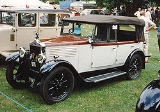
Standard Motor Company
Encyclopedia
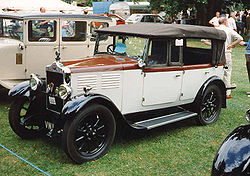
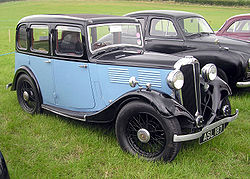
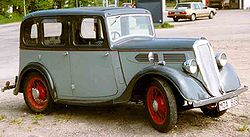
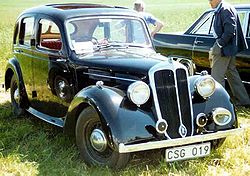
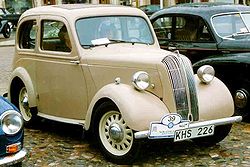
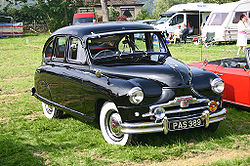
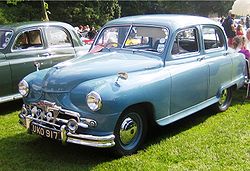

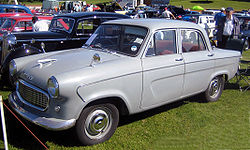
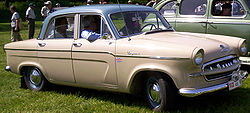
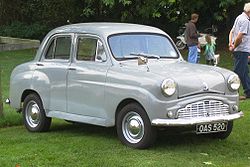
Coventry
Coventry is a city and metropolitan borough in the county of West Midlands in England. Coventry is the 9th largest city in England and the 11th largest in the United Kingdom. It is also the second largest city in the English Midlands, after Birmingham, with a population of 300,848, although...
, England in 1903 by Reginald Walter Maudslay
Reginald Walter Maudslay
Reginald Walter Maudslay was a British car manufacturer and founder of the Standard Motor Company. Born in Paddington, London, Maudslay was the son of Athol Edward Maudslay, "gentleman", and Kate, daughter of Sir Thomas Lucas, founder of a large firm of building contractors.Maudslay was educated...
(1871–1934). The Standard name was last used in Britain in 1963, and in India in 1987.
1903–1914
The company was first registered on 2 March 1903 by R. W. Maudslay. He was a civil engineer by profession but realised the enormous potential of the horseless carriage, and with a gift of £3,000 from Sir John Wolfe-Barrie he became a motor manufacturer, establishing a small factory in a two-storey building in Much Park Street, Coventry. Having undertaken the examination of several proprietary engines to familiarise himself with internal combustion engine design he employed seven people to assemble the first car, powered by a single-cylinder engine with three-speed gearbox and shaft drive to the rear wheels. By the end of 1903 three cars had been built and the labour force had been increased to twenty five. The increased labour force produced a car every three weeks during 1904.The single-cylinder model was soon replaced by a two-cylinder model quickly followed by three- and four-cylinder versions and in 1905 the first six. Even the first cars boasted shaft drive as opposed to chains, and the engines were not merely "square" but had 6" diameter pistons with a 3" stroke. As well as supplying complete chassis, the company found a good market selling engines for fitting to other cars, especially where the owner wanted more power. Although Alex Craig, a Scottish engineer, was engaged to do much of the detail work, Maudslay himself was sufficiently confident to undertake much of the preliminary layout. One of the several derivations of the name "Standard" is said to have emanated from a discussion between Maudslay and Craig during which the latter proposed several changes to a design on the grounds of cost, which Maudslay rejected, saying that he was determined to maintain the best possible "Standard".
In 1905 Maudslay himself drove the first Standard car to compete in a race. This was the Tourist Trophy in which he finished 11th out of 42starters, having had a non-stop run. In 1905 the first export order was also received, from a Canadian who arrived at the factory in person. The order was reported in the local newspaper with some emphasis, "Coventry firm makes bold bid for foreign markets".
The company displayed at the 1905 London Motor Show in Crystal Palace
Crystal Palace, London
Crystal Palace is a residential area in south London, England named from the former local landmark, The Crystal Palace, which occupied the area from 1854 to 1936. The area is located approximately 8 miles south east of Charing Cross, and offers impressive views over the capital...
, at which a London dealer, Charles (later Sir Charles) Friswell agreed to buy the entire factory output.
In late 1906 production was transferred to larger premises and output was concentrated on 6-cylinder models. The 16/20 h.p. tourer with side-entrance body was priced at £450. An indication of how much this was can be gained from the fact that a draughtsman earned £3 a week. In 1907 Friswell became company chairman. He worked hard to raise its profile, and the resulting increase in demand necessitated the acquisition of a large single-storey building in Cash's Lane, Coventry. Even this was inadequate after the publicity gained when a fleet of 20 cars, 16/20 tourers, were supplied for the use of Commonwealth editors attending the 1909 Imperial Press Conference in London. In 1909 the company first made use of the famous Union Flag Badge, a feature of the radiator emblem until after the Second World War. By 1911 the range of vehicles was comprehensive, with the 8-horsepower model being produced in quantity whilst a special order for two 70 hp cars was at the same time executed for a Scottish millionaire. Friswell's influence culminated in supplying seventy 4-cylinder 16 hp cars for King George V and his entourage, including the Viceroy of India, at the 1911 Delhi Durbah Coronation Festival Royal Durbah. In 1912 Friswell sold his interest in Standard to C. J. Band and Siegfried Bettmann
Siegfried Bettmann
Siegfried Bettmann was a bicycle, motorcycle and car manufacturer and initiator of the Triumph Motorcycle Company. In 1914 he established the Annie Bettmann Foundation to help young people start businesses Triumph became one of the most famous motorcycle trade-names of the world.-Early life:Born in...
, the founder of the Triumph Motor Cycle Company(which became the Triumph Motor Company). During the same year the first commercial vehicle was produced, and the 4-cylinder model "S" was introduced at £195, the first to be put into large-scale production. 1600 were produced before the outbreak of the First World War, 50 of them in the final week of car production. These cars were sold with a three-year guarantee. In 1914 Standard became a public company.
First World War
During the First World War the company produced more than 1000 aircraft, including the Royal Aircraft Factory BE12, Royal Aircraft Factory R.E.8Royal Aircraft Factory R.E.8
The Royal Aircraft Factory R.E.8 was a British two-seat biplane reconnaissance and bomber aircraft of the First World War designed by John Kenworthy. Intended as a replacement for the vulnerable B.E.2, the R.E.8 was more difficult to fly, and was regarded with great suspicion at first in the Royal...
, Sopwith Pup
Sopwith Pup
The Sopwith Pup was a British single seater biplane fighter aircraft built by the Sopwith Aviation Company. It entered service with the Royal Flying Corps and the Royal Naval Air Service in the autumn of 1916. With pleasant flying characteristics and good maneuverability, the aircraft proved very...
and Bristol F.2-B
Bristol F.2 Fighter
The Bristol F.2 Fighter was a British two-seat biplane fighter and reconnaissance aircraft of the First World War flown by the Royal Flying Corps. It is often simply called the Bristol Fighter or popularly the "Brisfit" or "Biff". Despite being a two-seater, the F.2B proved to be an agile aircraft...
in a new works at Canley that opened on 1 July 1916. Canley would subsequently become the main centre of operations. Other war materials produced included shells, mobile workshops for the Royal Engineers, and trench mortars.
1919–1939
Civilian car production was restarted in 1919 with models based on pre-war designs, for example the 9.5 model "S" was re-introduced as the model SLS although this was soon superseded by an 8 h.p. model.In the early 1920s saloon bodies were first offered; previously all cars had been tourers. The bodies had, since the move to Bishopsgate Green, been made in Coventry by the company itself, but it was not until 1922 that they were mass-produced, using a wooden track along which they were pushed by hand. The company was justifiably proud of the modern factory at Canley, boasting in its advertisements "It is a beautifully lighted and well-aired factory standing on the edge of a breezy common away from the city din and smoke, that the finishing touches and test are given to the All British 'Standard' Light cars which issue there to almost every quarter in the world".
It was about this time during the early 1920s that the slogan "Count them on the road" appeared on every advertisement. By 1924 the company had a share of the market comparable to Austin Motor Company
Austin Motor Company
The Austin Motor Company was a British manufacturer of automobiles. The company was founded in 1905 and merged in 1952 into the British Motor Corporation Ltd. The marque Austin was used until 1987...
, making more than 10,000 cars in 1924. As the immediate post-war boom faded, many rival marques were discontinued. Cars became steadily larger and more elaborate as manufacturers sought to maintain sales. During the 1920s all the models were named after towns, not only near the factory such as Canley and Kenilworth but also further afield – Teignmouth, Falmouth, and Exmouth.
By the late 1920s profits had decreased dramatically due to great reinvestment, a failed export contract and bad sales of the larger cars. In 1927 the inadvisability of matching the larger more elaborate trend became apparent and the 9 hp Fulham with fabric body was introduced at £185. Production was concentrated mainly on one basic chassis with a 9 hp engine. The importance of standardisation was now appreciated and only one alternative was offered. In 1929 Captain John Black
John Black (Motor industry)
Sir John Paul Black held several senior positions in the British motor industry including chairman of Standard-Triumph....
joined the board from Hillman
Hillman
Hillman is a British automobile marque created by the Hillman Motor Car Company, founded in 1907. The company was based in Ryton-on-Dunsmore, near Coventry, England. Before 1907 the company had built bicycles...
as joint Managing Director and one thing he encouraged was the supply of chassis to external coachbuilders such as Jensen
Jensen Motors
Jensen Motors Ltd was a British manufacturer of sports cars and commercial vehicles, based in the Lyng – West Bromwich...
, Avon and Swallow Sidecar Company
Swallow Sidecar Company
The Swallow Sidecar Company was founded on 4 September 1922 by two friends, William Walmsley and William Lyons . Both families lived in the same street in Blackpool, England. Walmsley had previously been making sidecars and bolting them onto reconditioned motorcycles...
(which would become Jaguar).
The coachbuilding company of Avon during the early 1930s commenced producing cars with a distinctly sporty appearance, using as a foundation, a complete chassis from the Standard Motor Company. These chassis were ordinary production units, used because of their sound engineering design and good performance. Known as Avon Standard Specials they catered for a select market too small for Standard themselves. Later the Swallow Sidecars coachbuilding company decided to produce a complete car and again utilised a Standard engine and chassis. This was known initially as the S.S. and later as the S.S. Jaguar, still using Standard mechanical parts.
It was not until 1930, after the replacement of artillery wheels by spoke wheels that the distinctive radiator shape first used on the 6-cylinder models in 1906 was finally abandoned. In 1930 before the worst of the depression the Big Nine was introduced which together with the 6-cylinder Ensign and Envoy constituted the complete range. Here standardisation was taken a step further with the bodies on 9 hp four-cylinder and 15 hp six-cylinder being almost indistinguishable except for bonnet length. The Big Nine was soon followed by the Big Twelve and sales for the second six months of 1931 exceeded those of the whole of the previous year. In 1932 there was a Royal visit to the Canley works by the Duke of Gloucester who came to open the Canley Pavilion outside which he took delivery of a new 6-cylinder model. Reginald Maudslay left the company two years after this honour and died soon afterwards on 14 December 1934 at the age of 64.
1935 saw all production transferred to the Canley site. Extensive re-organisation occurred including a continuous track being laid down in the paint shop on which the cars were completely painted.
Through the 1930s, fortunes improved with new models, the Standard Nine and Standard Ten which addressed the low to mid range market and at the Motor Show of 1935 the new range of Flying Standards was announced with semi streamlined bodies. The Flying Standards came to the market in 1936 with their distinctive streamlined sloping rears virtually replacing the existing range of Nine, Twelve, Sixteen, and Twenty. The Flying Standards were so-called because of the major radiator design change, topped by the Union Flag badge apparently streaming backwards in contrast to its previous forward-facing position. Almost all the Flying Standards had 4 cylinders, but in 1938 two new factories were opened at Fletchampstead and Banner Lane, and a completely new engine was offered. This was a 20 hp V8 which made British history by pioneering independent front suspension on a mass-produced light car, an achievement repeated exactly 21 years later with the independent rear suspension on the Herald.
The Southwards Car Museum on the Kapiti Coast, New Zealand has on display a Standard Flying V8 registered with an English number plate and which it claims only 350 were made. They state in their exhibit that 9 still exist in the world and New Zealand originally had 3 of them. The engine was a 20hp
Tax horsepower
The tax horsepower or taxable horsepower was an early system by which taxation rates for automobiles were reckoned in some European countries, such as Britain, Belgium, Germany, France, and Italy; some US states like Illinois charged license plate purchase and renewal fees for passenger...
Side Valve (90 degrees) V8 and the car had a listed maximum speed of 85 mi/h. It cost £349 when new.
By the beginning of the war, annual production was 50,000 units.
Second World War
The company continued to produce its cars during the Second World War, but now mainly fitted with utility bodies ("Tillies")Tilly (vehicle)
Tilly was the name given to a number of British military vehicles produced during World War II from civilian car designs and used by all of the armed forces in most theatres of that conflict.-History:...
. However, the most famous war-time product was the de Havilland Mosquito
De Havilland Mosquito
The de Havilland DH.98 Mosquito was a British multi-role combat aircraft that served during the Second World War and the postwar era. It was known affectionately as the "Mossie" to its crews and was also nicknamed "The Wooden Wonder"...
aircraft, mainly the FB VI version, of which more than 1100 were made. 750 Airspeed Oxford
Airspeed Oxford
The Airspeed AS.10 Oxford was a twin-engine aircraft used for training British Commonwealth aircrews in navigation, radio-operating, bombing and gunnery during the Second World War.-Design and development:...
s were also made as well as 20,000 Bristol Mercury
Bristol Mercury
|-See also:-Bibliography:* Bridgman, L, Jane's fighting aircraft of World War II. Crescent. ISBN 0-517-67964-7* Gunston, Bill. World Encyclopedia of Aero Engines. Cambridge, England. Patrick Stephens Limited, 1989. ISBN 1-85260-163-9...
VIII engines, and 3,000 Bristol Beaufighter
Bristol Beaufighter
The Bristol Type 156 Beaufighter, often referred to as simply the Beau, was a British long-range heavy fighter modification of the Bristol Aeroplane Company's earlier Beaufort torpedo bomber design...
fuselages.
Other wartime products included 4000 Beaverette
Standard Beaverette
Standard Car 4x2, or Car Armoured Light Standard, better known as the Beaverette, was a British armoured car produced during World War II.-History:...
light armoured cars and a lightweight "Jeep" type vehicle.
Post-war years
With peace, the pre-war EightStandard Eight
The Flying Eight was the smallest member of the Standard Flying family.Introduced in 1938 or 1939 , the Flying Eight featured, in its saloon form, the "streamlined" body of the little Standard Flying Nine which had appeared in 1937...
and Twelve cars were quickly back in production using tools carefully stored since 1939. Of greater significance was, in 1945, the purchase arranged by Sir John Black
John Black (Motor industry)
Sir John Paul Black held several senior positions in the British motor industry including chairman of Standard-Triumph....
for £75,000 of the Triumph Motor Company
Triumph Motor Company
The Triumph Motor Company was a British car and motor manufacturing company. The Triumph marque is owned currently by BMW. The marque had its origins in 1885 when Siegfried Bettmann of Nuremberg initiated S. Bettmann & Co and started importing bicycles from Europe and selling them with his own...
, which had gone into receivership in 1939. Triumph was reformed as a wholly owned subsidiary of Standard named "Triumph Motor Company (1945) Limited". The Triumph factory was near the city centre and was completely destroyed in the blitz. A lucrative deal was also arranged to build the small Ferguson Company
Ferguson Company
In about 1934, in company with David Brown, Harry Ferguson formed the Ferguson-Brown Company and the two men produced the Model A Ferguson-Brown tractor with a Ferguson-designed hydraulic hitch...
tractor which helped fill some of the large war time factory space. This arrangement was considered primarily by Black as a means to securing increased profits to fund new car development.
In December 1945 Standard Motor Company Limited announced that an arrangement had been made to manufacture Mr Harry Ferguson's world-famous tractors and Standard's newly acquired factory at Banner Lane Coventry would be used for the project. These tractors would be for the Eastern hemisphere, Ferguson tractors built by Ford in America for the Western hemisphere. Production was expected to start in 1946. Implements would be sourced separately by Ferguson who would also merchandise the tractors and the implements.
A one-model policy for the Standard marque (alongside a range of new Triumphs) was adopted in 1948 with the introduction of the 2 litre Standard Vanguard
Standard Vanguard
The car used a conventional chassis on which was mounted the American inspired semi-streamlined four-door body, which resembles a Plymouth. Suspension was independent at the front with coil springs and a live axle and leaf springs at the rear. Front and rear anti-roll bars were fitted. The brakes...
, which was styled on American lines by Walter Belgrove, and replaced all the carry-over pre-war models. This aptly named model was the first true post-war design from any major British manufacturer.. The beetle-back Vanguard Phase 1 was replaced in 1953 by the notch-back Phase 2 and in 1955 by the all-new Phase 3, which resulted in variants such as the Sportsman, Ensign, Vanguard Vignale and Vanguard Six.
The one-model policy lasted until 1953 when a new Standard Eight
Standard Eight
The Flying Eight was the smallest member of the Standard Flying family.Introduced in 1938 or 1939 , the Flying Eight featured, in its saloon form, the "streamlined" body of the little Standard Flying Nine which had appeared in 1937...
small car was added. This was introduced at £481. 7. 6. which meant it was the cheapest four-door saloon on the market yet it boasted independent front suspension, hydraulic brakes and an economical O.H.V. engine. At the same time in another part of the same building Standards were producing a very different engine, the Rolls Royce Avon jet aero engine of which 415 were made between 1951 and 1955. In 1954 the Eight was supplemented by the slightly more powerful Standard Ten
Standard Ten
thumb|right|250px|A 1934 Standard 10/12 SpeedlineThe Standard Ten was a small car produced by the British Standard Motor Company from 1906 to 1961....
which featured a wider chrome grille. The Phase II Vanguard was powered by a 2088 cc 4-cylinder "wet sleeve" engine
Standard inline-four engine
The Standard Motor Company 2,088 cc straight-4 engine was a petrol engine widely used for their passenger cars of the 1950s, most notably the Standard Vanguard. It was originally developed as an engine for Ferguson tractors....
producing 68 HP. This engine could be modified by using an additional intake system and two single-barrel Solex carburettors, producing 90 HP. Typically, the Phase II engine was one Solex carburettor, with 85 mm by 93 mm pistons. Standard Motors at the time supplied many of these engines to Ferguson Tractor distributed in the United States. The Ten was followed in its turn in 1957 by the Standard Pennant featuring very prominent tail fins, but otherwise little altered structurally from the 1953 Standard Eight. An option for the Ten, and standard fitment to the Pennant, was the Gold Star engine, tuned for greater power and torque than the standard 948 cc unit. Another tuning set, featuring a different camshaft and twin carburettors, was available from dealers.
As well as an overdrive
Overdrive (mechanics)
Overdrive is a term used to describe a mechanism that allows an automobile to cruise at sustained speed with reduced engine RPM, leading to better fuel economy, lower noise and lower wear...
for the gearbox, an option for the Eight, Ten and Pennant was the Standrive, a semi-manual transmission that automatically operated the clutch during gearchanges.
During the same year that the '8' was introduced, another car was displayed at the London Motor Show. This was a sports two-seater which had a modified Standard '8' chassis with a Vanguard engine in it. Its serious lack of luggage space, however, resulted in production being delayed until the next year when the tail was restyled to incorporate a generous boot. The car was badged as a 'Triumph' rather than a 'Standard' and the T.R.2 was a winner. Ken Richardson achieved 124 m.p.h. on the Jabbeke Highway in Belgium in a slightly modified car. As a result of the publicity, history repeated itself and small manufacturers again came to the Standard Motor Company for engines etc. including Morgan, Peerless, Swallow, and Doretti.
In 1958 the Standard Atlas panel van and pick-up was first vended, a cab-over-engine design. It initially used the 948 cc engine from the Standard 10, making the resulting vehicle woefully underpowered, even with its 6.66:1 final drive ratio. In 1961, the Atlas Major was introduced, and sold alongside the original 948 cc Atlas. This variant was powered by the Standard 1670 cc wet-liner motor, as used with different capacities in the Vanguard cars, and the Ferguson tractor. The same engine was also used in Triumph TR2, TR3 and TR4 sports cars. To use this larger engine, a substantial redesign of the cab interior and forward chassis was necessary. The vehicles were of a high standard but not priced competitively, which resulted in relatively few sales. In 1963 the Atlas Major became the Standard 15, with a new long wheelbase variant, with 2138 cc engine, became the Standard 20. Later that year, the Standard name became disused by Leyland, and these models were rebranded hastily as Leyland 15 and 20. By 1968 when production ended in the UK, all variants were powered by the 2138 cc engine and badged as Leyland 20s.
These vehicles were badged as "Triumphs" for export to Canada, and possibly other overseas markets. The van's tooling was also exported to India after UK production ceased, where the resultant vehicle continued in production until the 1980s.
By the later 1950s the small Standards were losing out in the UK market to more modern competitor designs, and the Triumph name was believed to be more marketable; hence the 1959 replacement for the Eight, Ten and Pennant was badged as the Triumph Herald
Triumph Herald
The Triumph Herald was a small two-door car introduced in 1959 by the Standard-Triumph Company of Coventry. Body design was by the Italian stylist Michelotti and the car was offered in saloon, convertible, coupé, van, and estate models....
; with substantial mechanical components carried over from the small Standards. Despite the separate chassis and independent rear suspension, the differential, hubs, brakes, engine and gearbox were all common to the last Standard Pennants. In order to build the Herald the company invested £2½ Million in a new assembly hall extension at the Canley plant which Standard had acquired in 1916. The builders of the three storey building excavated 250,000 tons of soil and rock. Inside the building were three 1300 ft assembly lines equipped to be one of the most modern car assembly plants in the world. This turned out to be the company's last investment on such a scale at Canley: investment decisions after the merge with Rover would favour the newer plant at Solihull.
Overseas assembly plants were opened in Australia, Canada, India and South Africa. Sir John Black resigned from control of the company in 1954. Ill-health was cited as the 'official' reason for his resignation but it is now known the Board of Directors requested he end his relationship with the company. His deputy and long-time personal assistant, Alick Dick, assumed control. The company started considering partners to enable continued expansion and negotiations were begun with Chrysler
Chrysler
Chrysler Group LLC is a multinational automaker headquartered in Auburn Hills, Michigan, USA. Chrysler was first organized as the Chrysler Corporation in 1925....
, Massey-Harris-Ferguson, Rootes Group, Rover
Rover (car)
The Rover Company is a former British car manufacturing company founded as Starley & Sutton Co. of Coventry in 1878. After developing the template for the modern bicycle with its Rover Safety Bicycle of 1885, the company moved into the automotive industry...
and Renault
Renault
Renault S.A. is a French automaker producing cars, vans, and in the past, autorail vehicles, trucks, tractors, vans and also buses/coaches. Its alliance with Nissan makes it the world's third largest automaker...
but these were inconclusive.
The Standard-Triumph company was eventually bought in 1960 by Leyland Motors Ltd
Leyland Motors Ltd
Leyland Motors Limited was a British vehicle manufacturer of lorries, buses and trolleybuses. It gave its name to the British Leyland Motor Corporation formed when it merged with British Motor Holdings, later to become British Leyland after being nationalised...
which paid £20 million and the last Standard, an Ensign Deluxe was produced in the UK in May 1963, when the final Vanguard models were replaced by the Triumph 2000
Triumph 2000
The Triumph 2000 is a mid-sized, rear wheel drive automobile which was produced in Coventry by the Triumph Motor Company between 1963 and 1977. Larger-engined models, known as the Triumph 2.5 PI and Triumph 2500 were also produced.-Engine:...
model. Triumphs continued when Leyland became British Leyland Motor Corporation
British Leyland Motor Corporation
British Leyland was a vehicle manufacturing company formed in the United Kingdom in 1968 as British Leyland Motor Corporation Ltd . It was partly nationalised in 1975 with the government creating a new holding company called British Leyland Ltd which became BL Ltd in 1978...
(later BL) in 1968. The Standard brand was ended on August 17, 1970 when a sudden announcement said that henceforth the Company was to be known as the Triumph Motor Company. The Standard name has been unused in Europe since then and the Triumph or Rover Triumph BL subsidiary used the former Standard engineering and production facilities at Canley
Canley
Canley is a suburban neighbourhood located in southwest Coventry, England. Canley became part of Coventry as a result of successive encroachment of the latter's boundaries between 1928 and 1932, having historically been part of the Stoneleigh parish....
in Coventry
Coventry
Coventry is a city and metropolitan borough in the county of West Midlands in England. Coventry is the 9th largest city in England and the 11th largest in the United Kingdom. It is also the second largest city in the English Midlands, after Birmingham, with a population of 300,848, although...
until the plant was closed in 1980.
BMW
BMW
Bayerische Motoren Werke AG is a German automobile, motorcycle and engine manufacturing company founded in 1916. It also owns and produces the Mini marque, and is the parent company of Rolls-Royce Motor Cars. BMW produces motorcycles under BMW Motorrad and Husqvarna brands...
acquired the Standard and Triumph brands following its purchase of BL's successor Rover Group
Rover Group
The Rover Group plc was the name given in 1986 to the British state-owned vehicle manufacturer previously known as British Leyland or BL. Owned by British Aerospace from 1988 to 1994, when it was sold to BMW, the Group was broken up in 2000 with the Rover and MG marques being acquired by the MG...
in 1994. When most of Rover was sold in 2000, BMW kept the Standard brand along with Triumph, MINI
Mini
The Mini is a small car that was made by the British Motor Corporation and its successors from 1959 until 2000. The original is considered a British icon of the 1960s, and its space-saving front-wheel-drive layout influenced a generation of car-makers...
and Riley. The management of British Motor Heritage
British Motor Heritage
British Motor Heritage Limited is a British company specialising in the manufacture of bodies and body parts for historic and classic British cars, and based in Witney, Oxfordshire.-History:...
Ltd, gained the rights to the Standard Brand upon their management purchase of this company from BMW in 2001 (reference BMH website linked below).
There was talk of a possible revival of the Standard name by MG Rover for its importation of the TATA Indica (reference Channel 4 website below). However, for reasons relating to the ownership of the brand by BMW, the car was finally launched as the CityRover.
Standard in India
The Standard name endured into the 1980s in India, where Standard Motor Products, Madras manufactured the Triumph HeraldTriumph Herald
The Triumph Herald was a small two-door car introduced in 1959 by the Standard-Triumph Company of Coventry. Body design was by the Italian stylist Michelotti and the car was offered in saloon, convertible, coupé, van, and estate models....
with the basic 948 cc engine as the Standard Herald during the 1960s, eventually with additional four-door and five-door estate models exclusively for the Indian market.
After 1970, Standard Motor Products split with British Leyland, and introduced a bodily restyled four-door saloon based on the Herald known as the Standard Gazel in 1971, using the same 948 cc engine but with a live rear axle, as the Herald's swing-axle was not liked much by Indian buyers and mechanics alike. The Gazel was built in small numbers – it has been suggested that it did so to keep its manufacturer's licence – until 1977. With the company concentrating solely on producing commercial vehicles based on the Leyland 20 model, badged as "Standard 20", production of Standard cars ceased until the Standard 2000, a rebadged Rover SD1
Rover SD1
Rover SD1 is both the code name and eventual production name given to a series of large executive cars made by British Leyland or BL through its Specialist, Rover Triumph and Austin Rover divisions from 1976 until 1986....
, was introduced in 1985. The car was higher and had a slightly modified old 1991 cc Standard Vanguard engine, as the company could not procure the licence to use the original Rover engine on this car, and was thus not successful, apart from the reasons that it had competition from cars with Japanese and other newer, fuel-efficient technology in India. It ceased production in 1987 and was the last car to have the Standard name.
Pre World War 1
| Year | Type | Engine | Production |
|---|---|---|---|
| 1903 | 6 hp | 1006 cc side-valve single-cylinder | |
| 1904–1905 | 12/15 | 1926 cc side-valve 2-cylinder | |
| 1905 | 16 hp | 3142 cc side-valve 4-cylinder | |
| 1905–1908 | 18/20 | 4714 cc side-valve 6-cylinder | |
| 1906 | 10 hp | 631 cc side-valve 2-cylinder | |
| 1906 | 16/20 | 3531 cc side-valve 4-cylinder | |
| 1906 | 24/30 | 5232 cc side-valve 6-cylinder | |
| 1906–1912 | 50 hp | 11734 cc side-valve 6-cylinder | |
| 1907 | 15 hp | 1593 cc side-valve 6-cylinder | |
| 1907–1908 | 30 hp | 5297 cc side-valve 6-cylinder | |
| 1908–1911 | 20 hp | 4032 cc side-valve 6-cylinder | |
| 1908–1911 | 40 hp | 6167 cc side-valve 6-cylinder | |
| 1909–1911 | 16 hp | 2688 cc side-valve 4-cylinder | |
| 1910–1911 | 12 hp | 1656 cc side-valve 4-cylinder | |
| 1911–1914 | 20 hp | 3620 cc (3336 cc from 1913) side-valve 6-cylinder | |
| 1911–1912 | 15 hp | 2368 cc side-valve 4-cylinder | |
| 1912 | 25 hp | 4032 cc side-valve 6-cylinder | |
| 1913–1918 | 9.5 hp Model S | 1087 cc side-valve 4-cylinder |
1919–1939
| Year | Type | Engine | Production |
|---|---|---|---|
| 1919–1921 | 9.5 hp Model SLS | 1328 cc side-valve 4-cylinder | |
| 1921–1923 | 8 hp | 1087 cc side-valve 4-cylinder | |
| 1921–1923 | 11.6 hp SLO | 1598 cc ohv 4-cylinder | |
| 1922–1926 | 13.9 hp SLO-4 | 1307 cc ohv 4-cylinder | |
| 1923–1927 | 11.4 hp V3 | 1307 cc ohv 4-cylinder | |
| 1926–1928 | 13.9 hp V4 | 1944 cc ohv 4-cylinder | |
| 1927–1928 | 18/36 hp | 2230 cc ohv 6-cylinder | |
| 1927–1930 | 9 hp | 1153 or 1287 cc side-valve 4-cylinder | |
| 1929–1933 | 15 hp | 1930 or 2054 cc side-valve 6-cylinder | |
| 1930–1933 | 9.9 hp Big Nine | 1287 cc side-valve 4-cylinder | |
| 1931–1935 | 20 hp Envoy | 2552 cc side-valve 6-cylinder | |
| 1932–1933 | Little Nine | 1006 cc side-valve 4-cylinder | |
| 1932–1933 | Little Twelve | 1337 cc side-valve 6-cylinder | |
| 1932–1933 | Big Twelve | 1497 cc side-valve 6-cylinder | |
| 1934 | 12/6 | 1497 cc side-valve 6-cylinder | |
| 1934–1935 | 10/12 Speed Model | 1608 cc side-valve 4-cylinder | |
| 1934–1936 | Nine | 1052 cc side-valve 4-cylinder | |
| 1934–1936 | Ten | 1343 cc side-valve 4-cylinder | |
| 1934–1936 | Twelve | 1608 cc side-valve 4-cylinder | |
| 1934–1936 | Sixteen | 2143 cc side-valve 6-cylinder | |
| 1935–1936 | Twenty | 2664 cc side-valve 6-cylinder | |
| 1937–1938 | Flying Ten Standard Ten thumb|right|250px|A 1934 Standard 10/12 SpeedlineThe Standard Ten was a small car produced by the British Standard Motor Company from 1906 to 1961.... |
1267 cc side-valve 4-cylinder | |
| 1937–1940 | Flying Twelve | 1608 cc side-valve 4-cylinder | |
| 1937–1940 | Flying Nine Standard Flying Nine The Flying Nine was a small family car produced by the British Standard Motor Company between 1937 and 1940. It was the smallest of several relatively streamlined cars with which the company, in common with several UK mass market competitors, widened and updated its range in the later 1930s.Behind... |
1131 cc side-valve 4-cylinder | |
| 1937–1940 | Flying Light Twelve | 1343 cc side-valve 4-cylinder | |
| 1937–1940 | Flying Fourteen Standard Flying Fourteen The Standard Fourteen is a five seater family car produced by the British Standard Motor Company from 1937 to 1939 . It was sometimes called the Standard Flying Fourteen because it represented a move away from the very perpendicular look of many cars at the start of the 1930s to a more... |
1608 cc or 1776 cc side-valve 4-cylinder | |
| 1936–1940 | Flying Sixteen | 2143 cc side-valve 6-cylinder | |
| 1936–1940 | Flying Twenty | 2663 cc side-valve 6-cylinder | |
| 19367-1938 | Flying V8 | 26868 cc side-valve V-8-cylinder | |
| 1938–1940 | Flying Eight Standard Eight The Flying Eight was the smallest member of the Standard Flying family.Introduced in 1938 or 1939 , the Flying Eight featured, in its saloon form, the "streamlined" body of the little Standard Flying Nine which had appeared in 1937... |
1021 cc side-valve 4-cylinder |
1945–1963
| Year | Type | Engine | Production |
|---|---|---|---|
| 1945–1948 | Eight Standard Eight The Flying Eight was the smallest member of the Standard Flying family.Introduced in 1938 or 1939 , the Flying Eight featured, in its saloon form, the "streamlined" body of the little Standard Flying Nine which had appeared in 1937... |
1021 cc side-valve four-cylinder | 383,139 |
| 1945–1948 | Twelve | 1608 cc side-valve 4-cylinder | 9959 |
| 1945–1948 | Fourteen Standard Flying Fourteen The Standard Fourteen is a five seater family car produced by the British Standard Motor Company from 1937 to 1939 . It was sometimes called the Standard Flying Fourteen because it represented a move away from the very perpendicular look of many cars at the start of the 1930s to a more... |
1776 cc side-valve 4-cylinder | 22,229 |
| 1947–1953 | Vanguard Phase I Standard Vanguard The car used a conventional chassis on which was mounted the American inspired semi-streamlined four-door body, which resembles a Plymouth. Suspension was independent at the front with coil springs and a live axle and leaf springs at the rear. Front and rear anti-roll bars were fitted. The brakes... |
2088 cc OHV 4-cylinder Standard inline-four engine The Standard Motor Company 2,088 cc straight-4 engine was a petrol engine widely used for their passenger cars of the 1950s, most notably the Standard Vanguard. It was originally developed as an engine for Ferguson tractors.... |
184,799 |
| 1953–1955 | Vanguard Phase II Standard Vanguard The car used a conventional chassis on which was mounted the American inspired semi-streamlined four-door body, which resembles a Plymouth. Suspension was independent at the front with coil springs and a live axle and leaf springs at the rear. Front and rear anti-roll bars were fitted. The brakes... |
2088 cc ohv 4-cylinder 2092 cc ohv 4-cylinder diesel |
81,074 1,973 |
| 1953–1957 | Eight Standard Eight The Flying Eight was the smallest member of the Standard Flying family.Introduced in 1938 or 1939 , the Flying Eight featured, in its saloon form, the "streamlined" body of the little Standard Flying Nine which had appeared in 1937... |
803 cc ohv 4-cylinder | 136,317 |
| 1954–1956 | Ten Standard Ten thumb|right|250px|A 1934 Standard 10/12 SpeedlineThe Standard Ten was a small car produced by the British Standard Motor Company from 1906 to 1961.... |
948 cc ohv 4-cylinder | 172,500 |
| 1955–1958 | Vanguard Phase III Standard Vanguard The car used a conventional chassis on which was mounted the American inspired semi-streamlined four-door body, which resembles a Plymouth. Suspension was independent at the front with coil springs and a live axle and leaf springs at the rear. Front and rear anti-roll bars were fitted. The brakes... |
2088 cc ohv 4-cylinder | 37,194 |
| 1956–1957 | Sportsman Standard Vanguard The car used a conventional chassis on which was mounted the American inspired semi-streamlined four-door body, which resembles a Plymouth. Suspension was independent at the front with coil springs and a live axle and leaf springs at the rear. Front and rear anti-roll bars were fitted. The brakes... |
2088 cc ohv 4-cylinder | 901 |
| 1957–1961 | Ensign | 1670 cc ohv 4-cylinder 2092 cc ohv 4-cylinder diesel |
18,852 |
| 1957–1959 | Pennant Standard Ten thumb|right|250px|A 1934 Standard 10/12 SpeedlineThe Standard Ten was a small car produced by the British Standard Motor Company from 1906 to 1961.... |
948 cc ohv 4-cylinder | 42,910 |
| 1958–1961 | Vanguard Vignale Standard Vanguard The car used a conventional chassis on which was mounted the American inspired semi-streamlined four-door body, which resembles a Plymouth. Suspension was independent at the front with coil springs and a live axle and leaf springs at the rear. Front and rear anti-roll bars were fitted. The brakes... |
2088 cc ohv 4-cylinder | 26,276 |
| 1960–1963 | Vanguard Six Standard Vanguard The car used a conventional chassis on which was mounted the American inspired semi-streamlined four-door body, which resembles a Plymouth. Suspension was independent at the front with coil springs and a live axle and leaf springs at the rear. Front and rear anti-roll bars were fitted. The brakes... |
1998 cc ohv 6-cylinder | 9953 |
| 1962–1963 | Ensign II Standard Vanguard The car used a conventional chassis on which was mounted the American inspired semi-streamlined four-door body, which resembles a Plymouth. Suspension was independent at the front with coil springs and a live axle and leaf springs at the rear. Front and rear anti-roll bars were fitted. The brakes... |
2138 cc ohv 4-cylinder | 2318 |
Military and commercial
| Year | Type | Engine | Production |
|---|---|---|---|
| 1940–1943 | Beaverette Standard Beaverette Standard Car 4x2, or Car Armoured Light Standard, better known as the Beaverette, was a British armoured car produced during World War II.-History:... |
1,776 cc side-valve 4-cylinder | |
| 1940–1944 | 12 hp Light Utility | 1,608 cc side-valve 4-cylinder | |
| 1943 | Jeep | 1,608 cc side-valve 4-cylinder | |
| 1947–1958 | 12 cwt | 2,088 cc ohv 4-cylinder | |
| 1954–62 | 6 cwt | 948 cc ohv 4-cylinder | |
| 1958–1962 | 10 hp Atlas | 948 cc ohv 4-cylinder | |
| 1962–1963 | Atlas Major | 1,670 cc ohv 4-cylinder | |
| 1962–1965 | 7 cwt | 1,147 cc ohv 4-cylinder |

